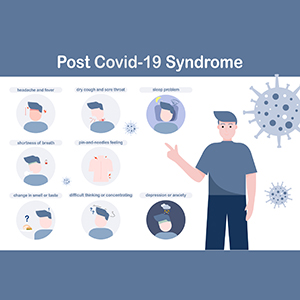Efficacy of a rehabilitation protocol on pulmonary and respiratory muscle function and ultrasound evaluation of diaphragm and quadriceps femoris in patients with post-COVID-19 syndrome: a series of cases

Submitted: January 19, 2022
Accepted: June 8, 2022
Published: June 20, 2022
Accepted: June 8, 2022
Abstract Views: 2059
PDF: 703
Publisher's note
All claims expressed in this article are solely those of the authors and do not necessarily represent those of their affiliated organizations, or those of the publisher, the editors and the reviewers. Any product that may be evaluated in this article or claim that may be made by its manufacturer is not guaranteed or endorsed by the publisher.
All claims expressed in this article are solely those of the authors and do not necessarily represent those of their affiliated organizations, or those of the publisher, the editors and the reviewers. Any product that may be evaluated in this article or claim that may be made by its manufacturer is not guaranteed or endorsed by the publisher.
Similar Articles
- Fortuna Lubrano, Ilaria Fucile, Maurizio Conte, Ciro Santoro, Francesco Rozza, Nicola De Luca, Costantino Mancusi, Adherence to Mediterranean diet among patients with acute cardiovascular events admitted in Cardiac Rehabilitation unit , Monaldi Archives for Chest Disease: Vol. 93 No. 3 (2023)
- Guido Levi, Marco Umberto Scaramozzino, Stefania Cavallo, Giuliano Castignini, Michela Bezzi, Laura Pini, Frank Nania, Sheenam Sheenam, Pulmonary rehabilitation improves functional outcomes and quality of life in post-SARS-CoV-2 mild-to-moderate infection patients: a pilot study , Monaldi Archives for Chest Disease: Vol. 94 No. 1 (2024)
- Laura Bertacchini, Mara Paneroni, Laura Comini, Simonetta Scalvini, Michele Vitacca, Recovering of oxygenation, physical function and disability in patients with Covid-19 , Monaldi Archives for Chest Disease: Vol. 91 No. 4 (2021)
- A.J. Lopes, T.T. Mafort, A. de Sá Ferreira, M.C. Santos de Castro, M. de Cássia Firmida, E. de Andrade Marques, Is the type of chronic pulmonary infection a determinant of lung function outcomes in adult patients with cystic fibrosis? , Monaldi Archives for Chest Disease: Vol. 77 No. 3-4 (2012): Pulmonary series
- C. Ortolani, F. Agostinis, S. Amoroso, R. Ariano, A. Barbato, M. Bassi, G. Cadario, P. Campi, F. Cardinale, G. Ciprandi, R. D’Anneo, M. Di Gioacchino, V. Di Rienzo, A. Fiocchi, M. Galimberti, E. Galli, M. Giovannini, C. Incorvaia, S. La Grutta, C. Lombardi, F. Marcucci, G. Marseglia, M. Minelli, A. Musarra, E. Nettis, E. Novembre, G. Pajno, G. Patriarca, F. Pezzuto, P. Piras, S. Pucci, A. Romano, C. Romano, O. Quercia, G. Scala, D. Schiavino, G. Sforza, M. Tosca, S. Tripodi, F. Frati, Practice parameters for sublingual immunotherapy , Monaldi Archives for Chest Disease: Vol. 65 No. 1 (2006): Pulmonary series
- Annamaria Municinó, Annamaria Nicolino, Manlio Milanese, Edoardo Gronda, Bruno Andreuzzi, Fabrizio Oliva, Francesco Chiarella, Hydrotherapy in Advanced Heart Failure: the Cardio-HKT Pilot Study , Monaldi Archives for Chest Disease: Vol. 66 No. 4 (2006): Cardiac series
- M. Vitacca, L. Bianchi, L. Barbano, N. Ambrosino, Lung and respiratory muscle function at discharge from a respiratory intensive care unit , Monaldi Archives for Chest Disease: Vol. 63 No. 3 (2005): Pulmonary series
- Federica Scimia, Isabella Casadei, Elena Cerquetani, Mara Piccoli, Alessandro Villa, Salvatore La Carrubba, Alessandro Salustri, Functional evaluation of ultra-octogenarian patients undergoing Cardiac Rehabilitation: correlation between Six minute Walking Test and Rivermead Mobility Index , Monaldi Archives for Chest Disease: Vol. 74 No. 4 (2010): Cardiac series
- Duccio Rossini, Massimo Bulckaen, Stefano Di Marco, Roberto Giovannetti, Franco Giuntoli, Luciana Iacopetti, William Vergoni, Rehabilitation program in patients with moderate-to-severe intermittent claudication: immediate results and one year follow-up , Monaldi Archives for Chest Disease: Vol. 68 No. 2 (2007): Cardiac series
- Massimo Penna, Luca Nicoli, Psychological participation in cardiological rehabilitation: an experience of reduction of anxiety states through a psychological group of discussion , Monaldi Archives for Chest Disease: Vol. 68 No. 4 (2007): Cardiac series
<< < 4 5 6 7 8 9 10 11 12 13 > >>
You may also start an advanced similarity search for this article.

 https://doi.org/10.4081/monaldi.2022.2206
https://doi.org/10.4081/monaldi.2022.2206





